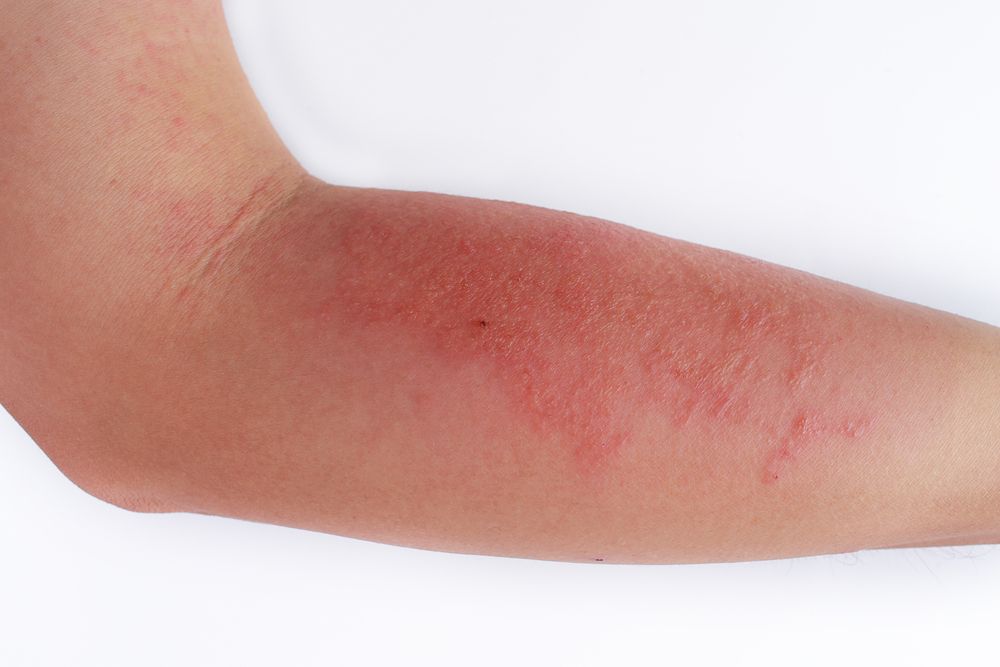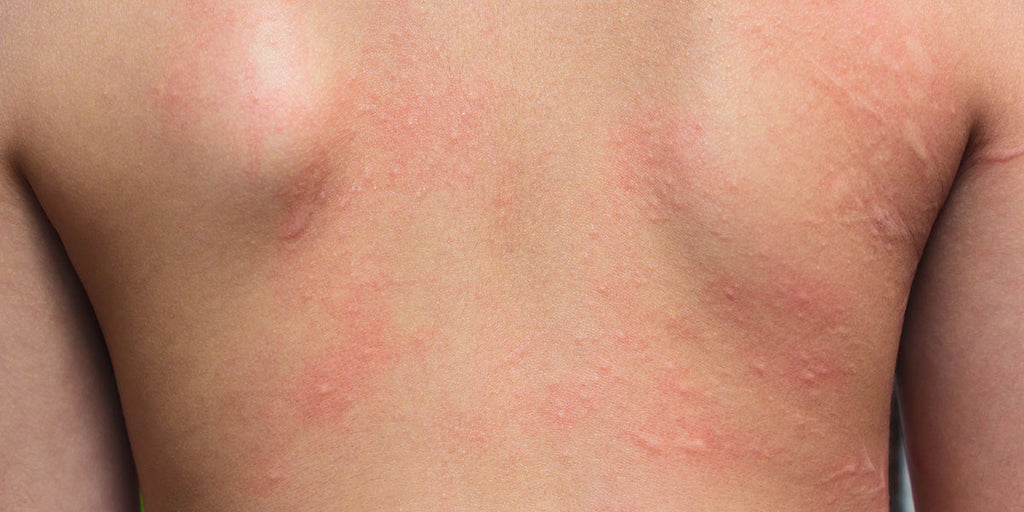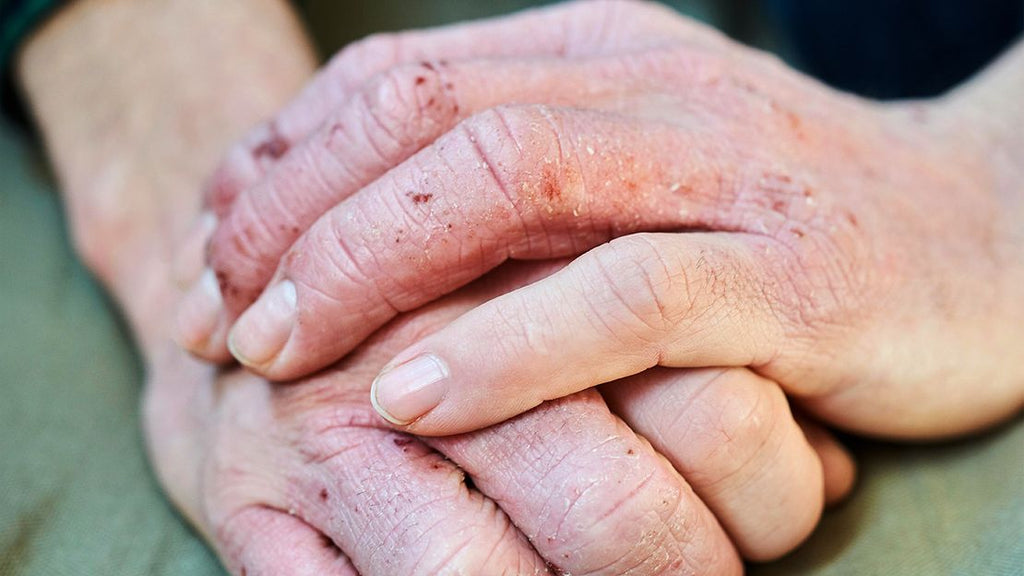If your skin is itchy and red from time to time, you may have eczema. This skin condition is common in children, but adults can get it too. Eczema is sometimes called atopic dermatitis, which is the most common form. "Atopy" refers to allergies. People with eczema often have allergies or asthma, as well as itchy, red skin. Eczema also comes in several other forms. Each type of eczema has its own set of symptoms and triggers. All types of eczema also have some common symptoms such as dry, scaly skin, redness, and severe itching.
Atopic dermatitis
Atopic dermatitis is the most common form of eczema. It usually begins in childhood and often becomes milder or disappears in adulthood. Atopic dermatitis is part of what doctors call the "allergic triad." The other two diseases in the "triad" are asthma and hay fever. Many people with atopic dermatitis have all three conditions.

Symptoms of atopic dermatitis
- The rash usually appears in the creases of the elbows or knees
- The skin in the area where the rash occurs may become lighter, darker, or thicker
- If you scratch them, small bumps may appear and leak fluid
- Babies often develop rashes on their scalp and cheeks
- If you scratch it, your skin can become infected
Causes of atopic dermatitis
Atopic dermatitis occurs when your skin's natural barrier to certain objects weakens. This means your skin is unable to protect you from irritants and allergens. Atopic dermatitis may be caused by a combination of factors, such as:
- Gene
- Dry skin
- Immune system problems
- Triggers in the environment
Contact dermatitis
If your skin becomes red and inflamed in response to a substance it comes into contact with, you may have contact dermatitis. It comes in two types: Allergic contact dermatitis is an immune system reaction to an irritant like latex or metal. Irritant contact dermatitis occurs when chemicals or other substances irritate your skin.

Symptoms of contact dermatitis
- Your skin itches, becomes red, burns, and stings
- Itchy bumps called hives may appear on your skin
- Fluid-filled blisters may form, which may ooze and crust over
- Over time, the skin may thicken and feel scaly or leathery
Causes of contact dermatitis
Contact dermatitis occurs when you come into contact with a substance that irritates your skin or causes an allergic reaction. The most common reasons are:
- Detergent
- Bleach
- Jewelry
- Latex
- Nickel
- Painting
- Poison ivy and other poisonous plants
- Skin care products, including cosmetics
- Soaps and Perfume
- Solvent
- Tobacco Smoke
Dyshidrotic eczema
Dystrophic eczema causes small blisters to form on the hands and feet. This is more common in women than men.

Symptoms of sweat herpes
- Fluid-filled blisters develop on fingers, toes, palms, and soles
- These blisters may be itchy or painful
- Skin can scale, crack and peel
Causes of sweat herpes
- Allergies
- Damp hands and feet
- Contact with substances such as nickel, cobalt or chromium salts
- Pressure
Hand eczema
Eczema that only affects the hands is called hand eczema. You may develop this type of disease if you have a job such as hairdressing or cleaning where you regularly use chemicals that irritate your skin.

Symptoms of hand eczema
- Your hands will become red, itchy, and dry
- They may form cracks or water
Causes of hand eczema
Hand eczema caused by exposure to chemicals. People who work in jobs where they are exposed to irritants are more likely to get this form, such as:
- Cleaning
- Haircut
- Health care
- Laundry or dry cleaning
Neurodermatitis
Neurodermatitis is similar to atopic dermatitis. It causes thick, scaly patches on the skin.

Symptoms of neurodermatitis
- Thick, scaly patches develop on your arms, legs, back of neck, scalp, soles of feet, back of hands, or genitals
- These patches may be itchy, especially when you are relaxing or asleep
- If you scratch the patches, they will bleed and become infected
Causes of neurodermatitis
Neurodermatitis often begins in people with other types of eczema or psoriasis. Although stress may be a trigger, doctors don't know exactly what causes it.
Nummular eczema
This type of eczema causes round, coin-shaped spots on your skin. The word "nummular" means coin in Latin. Nummular eczema looks very different from other types of eczema and can be very itchy.
Symptoms of nummular eczema
- Circle, coin-shaped spots form on your skin
- The spots may become itchy or scaly
Causes of nummular eczema
Nummular eczema can be triggered by a reaction to an insect bite or an allergic reaction to metals or chemicals. Dry skin can also cause it. You are more likely to get this form if you have another type of eczema, such as atopic dermatitis.
Stasis dermatitis
Stasis dermatitis occurs when fluid leaks into the skin from delicate veins. This fluid can cause swelling, redness, itching, and pain.
Symptoms of smoldering dermatitis
- You may have swelling in the lower parts of your legs, especially during the day when you walk
- Your legs may hurt or feel heavy
- You may also have varicose veins, which are large, cord-like, damaged veins in your legs
- The skin of those with varicose veins will be dry and itchy
- You may develop open sores on your calves and toes
Causes of smoldering dermatitis
Smoldering dermatitis occurs in people who have blood flow problems in their lower legs. If the valves that normally push blood up through the legs toward the heart malfunction, blood can pool in the legs. Your legs may swell and develop varicose veins.
See a doctor for eczema
If the itching and redness you experience doesn't go away on its own or is interfering with your daily life, see your doctor. A dermatologist can diagnose and treat eczema.
To help your doctor understand your condition, it may be helpful to keep a journal to identify your eczema triggers. Write it down:
- What do you eat and drink
- What skin care products, chemicals, soaps, cosmetics and cleansers do you use
- What activities do you do, such as walking in the woods or swimming in a chlorinated pool
- The length of your bath or shower, and the water temperature
- When you are stressed
You should start to notice a connection between your activities and eczema flare-ups. Bring this journal to your doctor to help them pinpoint your triggers.
Allergy specialists can also perform patch tests. This test places a small amount of an irritating substance on a patch that is placed on the skin. The patch will stay on your skin for 20 to 30 minutes to see if you have a reaction. This test can help your doctor determine which substances trigger your eczema so you can avoid them.
Treatment of eczema
Eczema often comes and goes. When it occurs, you may need to try different medications and other treatments to get rid of it.
- Antihistamines such as diphenhydramine (Benadryl) can control itching.
- Corticosteroid creams or ointments can reduce itching. For more severe reactions, you can take oral steroids such as prednisone (Rayos) to control swelling.
- Calcineurin inhibitors such as tacrolimus (Protopic) and pimecrolimus (Elidel) reduce the immune response that causes red, itchy skin.
- Antibiotics treat skin infections.
- Light therapy exposes your skin to ultraviolet light to heal the rash.
- Using a cold compress before applying corticosteroid cream can help the medicine get into your skin more easily.
If an allergic reaction causes an eczema flare-up, the eczema-causing substance should be avoided.
Tips to Reduce Eczema Outbreaks
Here are some ways to prevent eczema flare-ups and manage symptoms:
- Apply a cold compress to the skin, or take a colloidal oatmeal or baking soda bath to relieve itching.
- Moisturize your skin daily with a rich, oil-based cream or ointment to form a protective barrier against the elements. Apply the cream immediately after showering or bathing to lock in moisture.
- After bathing, gently wipe skin with a soft towel. Never rub.
- Avoid scratching. You may cause an infection.
- Use fragrance-free cleansers, cleansers, makeup, and other skin care products.
- Wear gloves and protective clothing when handling chemicals.
- Wear loose-fitting clothing made of soft fibers, such as cotton.
You should also avoid anything known to trigger eczema.
















